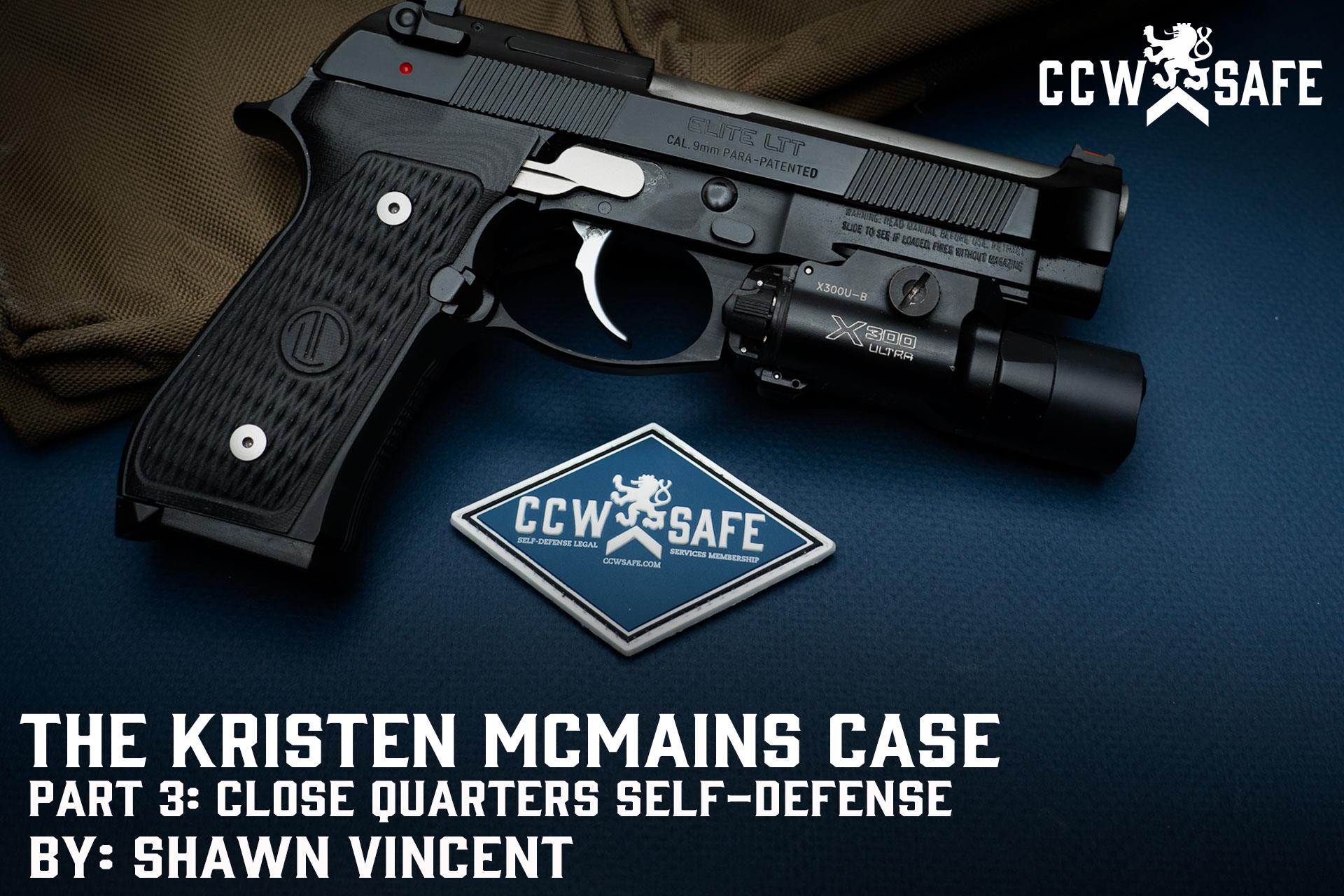
Posted on June 18, 2021
The Kristen McMains Case Pt.3
The Kristen McMains Case
Part 3: Close Quarters Self-Defense
Kristen McMains, a 25-year-old lawyer in Louisville, Kentucky, first became suspicious that John Ganobcik was stalking her when she traversed the skywalk connecting her office building to the parking garage across the street. She felt her fears were confirmed when she boarded an elevator and the suspicious man followed — but did not press a button. When the doors opened on the fourth level of the parking garage, she bolted for her car, and Ganobcik sprinted after her.
Before McMains could get in her car, her attacker caught up, slammed her head, and jabbed at her with an eight-inch rusty serrated knife. He forced her into the passenger seat and said, “We’re going.” Fearing rape and murder, McMains fought viciously to escape, tearing off all 10 of her fingernails in the struggle, but she was unable to escape. Desperate, she told Ganobcik that she had just cashed a check and could offer him money. When she reached for her purse, instead of money, she pulled out the .32 Beretta Tomcat her father had bought for her.
At first, it failed to fire, but McMains kept pulling the trigger and ultimately she shot Ganobcik in the neck and the buttocks. He fled, and a passerby called 911. Eventually, Ganobcik pled guilty to robbery and attempted kidnapping, receiving a 15-year prison sentence. McMains’ use of force was immediately recognized as justified.
McMains spoke to reporters about her decision to carry a gun. “I would never want to inflict violence on somebody,” she said. “It’s a personal decision. Some women might want to carry pepper spray.” Others, she suggested, may train in self-defense.
Using pepper spray, of course, is part of self-defense training, and firearms instructor Tatiana Whitlock discourages the “I’m not a pepper spray kind of girl” mentality. CCW Contributor Steve Moses agrees and highly recommends OC spray be a part of an armed defender’s toolkit. Steve stresses that the decision to carry pepper spray or a firearm is not an either/or decision. That being said, OC spray is not always a viable option in every self-defense scenario.
In our exploration of high-profile self-defense shootings, we have encountered many cases where armed defenders clashed with unarmed attackers, situations where the use of a firearm would be considered disproportionate and unjustified, but where pepper spray may have legally and successfully ended the assault. I asked Steve Moses if the McMains case might have been one of those cases where pepper spray would have been a viable tool.
“Based upon what I read about the case,” Steve says, “I’m not sure that she would ever have the opportunity to use pepper spray. It’s often not effective when you’re attacked at relatively short range and when the person is moving in a rapid manner.” In the elevator, Ganobcik did not yet demonstrate the intent to attack McMains, not enough to justify the use of force — even just pepper spray — and even if he had, he was probably too close for her to effectively deploy it. If McMains had stopped to deploy pepper spray while running through the garage, it’s unlikely she would have been able to give Ganobcik an effective dose before he overtook her. Once in the car, it would have been difficult to deploy, and the attacker, even with burning eyes, was still in a position to inflict great bodily harm or death.
OC spray, while a critical part of the defender’s toolkit, is not an answer for every self-defense problem. Steve suggests that having a small fixed blade knife can bridge the gap between pepper spray and a firearm. If McMains had a knife, and more importantly, the proper training to use it, she may have been able to inflict enough pain on her attacker to stop the assault before he forced her into her vehicle — without her ripping off all her fingernails in a desperate struggle. Don West, criminal defense lawyer and National Trial Counsel for CCW Safe, cautions us that, unlike OC spray, a knife is a deadly weapon; carrying a knife in certain locations may be against the law, and compared to pepper spray, displaying or deploying a blade presents a greater legal risk for the defender.
It wasn’t until McMains had been forced into the passenger seat of her own car that she managed to retrieve her concealed pistol. Steve Moses notes that there are perils associated with deploying a firearm at such close range. When McMains pulled her pistol from her purse, Steve says, “she was more than likely extending that gun away from her body where it could have been grabbed.” Luckily, Ganobcik didn’t get a hold of the weapon, but had he been able to disarm her, he could have used the pistol against her. Such incidents are, sadly, not unheard of, and being shot with your own firearm is what The Tactical Professor, our friend Claude Werner, would call a “bad result.”
Firearms instructor Tatiana Whitlock, who brought the McMains story to our attention, is trained in retention shooting. So is Steve Moses, and he gives a lot of the credit for that to renowned instructor Craig Douglas who, Steve says, has a fantastic system of retention shooting. “A lot of instructors teach how to use a handgun in close proximity to another person in such a way that’s difficult for them to disarm you, and so you always know where the muzzle of that handgun is so that you don’t inadvertently shoot yourself,” Steve says. Retention shooting is an important skill for concealed carriers to develop.
None of this is meant to be critical of Kristen McMains who valiantly used the tools and the training she had to successfully end a potentially deadly assault. “The fact that she just kept at it is a testament to her spirit over her equipment,” Tatiana Whitlock says. “She kept fighting. She did not stop, and that alone is one of the strongest self-defense realities we try to impart to women. You fight until you win. You fight until it’s over.”
The lesson for concealed carriers is that self-defense is not about the decision to carry a firearm or not. It’s not about deciding between carrying pepper spray or a gun. Self-defense is about having the tools and the training to solve what Tatiana Whitlock calls self-defense “problems.” It means knowing how to deal with physical threats in a variety of situations. The more training you have with different tools and tactics — including less lethal options — the more choices you have when faced with a threat, and the more likely you’ll be to have what Claude Werner calls a “positive outcome.”
